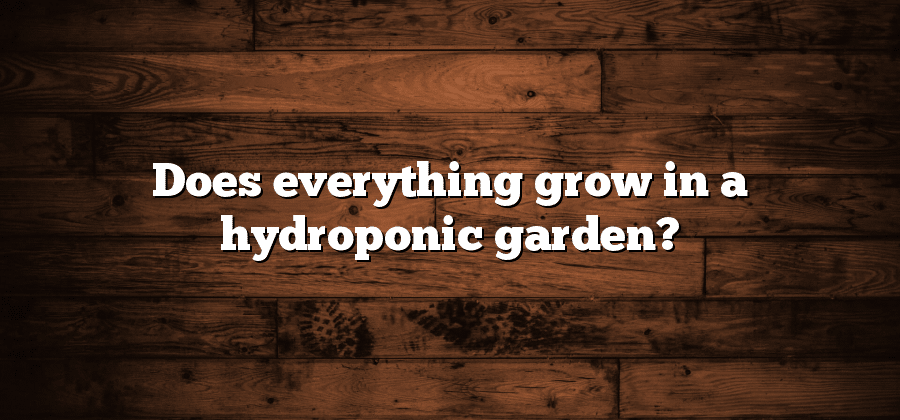Explanation of Hydroponic Gardening
Hydroponic gardening, also known as soil-less gardening, is a method of cultivating plants using water-based nutrient solutions rather than traditional soil. In hydroponics, plants are grown in a controlled environment where essential nutrients are delivered directly to their roots. This method allows for precise control over the nutrient intake of plants, ensuring optimal growth and productivity.
One key aspect of hydroponic gardening is the use of a growing medium, which provides support for the roots and anchors the plants in place. Commonly used growing mediums include perlite, vermiculite, and coco coir. By eliminating the need for soil, hydroponic gardening offers several advantages. It allows plants to access nutrients more efficiently, resulting in faster growth and higher yields. Additionally, since the growing medium is sterile, the risk of crop diseases and pests is significantly reduced.
Benefits of Hydroponic Gardening
Hydroponic gardening offers numerous benefits that make it an increasingly popular choice among gardeners. Firstly, this method allows for year-round cultivation regardless of weather conditions, making it particularly appealing for those in extreme climates or urban areas with limited space. As the plants are grown in a controlled environment, they are not subject to the same risks of pests or diseases that can plague traditional soil-based gardens. This reduces the need for chemical pesticides and herbicides, making hydroponic gardening a more environmentally friendly option.
Additionally, hydroponic gardening is known for its efficiency and productivity. By providing plants with direct access to water and nutrients, they are able to grow faster and produce higher yields compared to traditional gardening methods. Moreover, the precise control over nutrient solutions in hydroponic systems allows for optimal absorption by plants, resulting in healthier and more nutritious produce. This aspect of hydroponic gardening is particularly important in areas where access to fresh, locally grown food is limited.
Types of Plants that Thrive in Hydroponic Gardens
Hydroponic gardening provides a unique opportunity to grow a vast array of plants without the need for soil. In fact, many different types of plants thrive in hydroponic gardens, making it a versatile and customizable method of cultivation for enthusiastic gardeners. From leafy greens to vibrant herbs, and even fruiting crops, hydroponic systems can support a wide range of plant varieties.
Leafy greens such as lettuce, spinach, and kale are among the most popular choices for hydroponic gardening due to their ability to grow quickly and yield abundant harvests. These plants thrive in nutrient-rich water solutions, allowing them to grow lush and full. Additionally, herbs like basil, mint, and cilantro also excel in hydroponic settings, as they can take advantage of the optimal nutrient delivery and controlled environment. With hydroponics, these herbs can be harvested continuously, providing a fresh and aromatic addition to any culinary creation.
Moreover, hydroponic gardens also have the capability to support fruiting crops, including tomatoes, cucumbers, and strawberries. These plants typically require larger systems and more specialized care, but the rewards are well worth the effort. With careful nutrient management and support structures, hydroponic environments can produce high-quality, flavorful fruits that are free from soil-borne diseases and pests. Whether you have a passion for leafy greens, aromatic herbs, or even bountiful fruits, hydroponic gardening offers endless possibilities for cultivating thriving plants in a controlled and efficient manner.
Factors to Consider for Successful Hydroponic Gardening
Hydroponic gardening offers a unique and innovative way to grow plants without soil. However, like any other gardening method, there are certain factors that need to be considered for successful results. The first factor to consider is the **pH level**, which is a measure of acidity or alkalinity in the nutrient solution. Different plants have different pH preferences, so it is important to monitor and adjust the pH levels accordingly. Additionally, **nutrient balance** is crucial in hydroponic gardening. Plants require a range of essential nutrients to grow and thrive, and these nutrients need to be provided in the right proportions. Regular testing of nutrient levels and proper nutrient supplementation are vital to ensure optimal plant growth.
Another important factor to consider is the **growing environment**. Hydroponic gardens require adequate lighting, ventilation, and temperature control. Choosing the right type of **grow lights** is essential for providing the necessary light spectrum and intensity for plant growth. Adequate **air circulation** is also crucial to prevent the buildup of excess moisture and the growth of mold or other pests. Additionally, maintaining a **stable temperature** is important to ensure optimal photosynthesis and overall plant health. Proper insulation and ventilation systems can help regulate temperature fluctuations and create an ideal growing environment for hydroponic plants.






